When will you visit Japan?
Japan is located in the temperate zone, and has four seasons.
In any season, you can enjoy Japan.
But, summer is hotter and longer than before due to global warming.
About the climate in four seasons, please check the following page.
In each month, there are various events in the climate.
If you plan your travel to Japan, it may be useful to know the feature of the month in Japan.
Spring
March
April
May
Summer
June
July
August
Autumn
September
October
November
Winter
December
January
February
Spring
March
It is still cold in early March.
In the mainland of Japan, it is 5°C to 15°C and the temperature varies from day to day.
In Hokkaido, the day's high temperature is around zero.
But, in Okinawa islands, it is around 20°C, so the area is already spring.
It rains every few days and a little warm day sometimes appears.
The temperature rises little by little from mid-March.
From late February to early March, ume blossoms (Japanese plum, or Japanese apricot) bloom.
Ume is the popular blossom as a herald of spring and has been loved by Japanese people since ancient times.
Famous ume gardens are dotted throughout Japan, and we can also see the blossoms in some famous Shinto shrine and Buddhist temple.
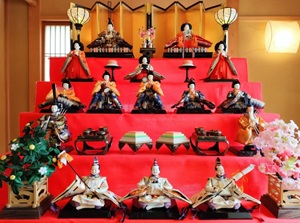
Hina-Dolls for Doll Festival
March 3 is Doll Festival (Hina-Matsuri in Japanese).
This is an occasion to pray for young girls' growth and happiness, and most homes with girls display Hina-dolls in a room.
The set of Hina-dolls shows the wedding scene of ancient court noble, and it is a family treasure.
You may be able to see displayed dolls in various places.
In Japan, the school year ends in March and the graduation ceremony is held.
Spring break of all schools starts in late March, so you will find the children enjoying the vacation in many spots.
The early-blooming cherry trees have already been flowering in parts of Japan, but most popular kind of cherry tree is "Somei-Yoshino" and Japanese people love it.
From mid-March, cherry blossom forecast of Somei-Yoshino is broadcast on TV every day.
This is the primary concern of Japanese people in this season.
And the cherry blossoms start blooming in the south of Japan in the end of March.
April
In the mainland of Japan, the temperature is 15°C to 20°C in April and it exceeds 20°C in late April.
In Hokkaido, the temperature often exceeds 10°C.
And, in Okinawa islands, the temperature often exceeds 25°C.
From late March to early April, cherry blossoms (Sakura in Japanese) attract Japanese people, and the information about the status of the cherry blossoms in many cities are announced on news programs.
Cherry blossoms are seen in any city, town and village in Japan, and there are popular park with a lot of cherry trees.
Needless to say, sakura is the symbol of Japan, and Japanese people love Sakura.
Know about Sakura in Japan in the following page.
The area where the cherry blossoms bloom moves from southern Japan to northern Japan.
The season is in late April in Tokoku Region, and is in early May in Hokkaido.
In Hokkaido, April is still in early spring.
April is the beginning of the fiscal year for companies and the start of a new school year for Japanese schools.
So, the atmosphere of Japanese society is fresh and full of energy in April.
And, cherry blossoms also create the atmosphere.

Azaleas in Osaka Castle
After Sakura season, the azaleas become in full bloom.
Azereas have also planted throughout Japan since ancient times, so you can see in various places.
And, fresh green leaves grow in the forest.
From around the end of April to the beginning of May, Golden Week starts.
It is the spring holiday season in Japan.
May
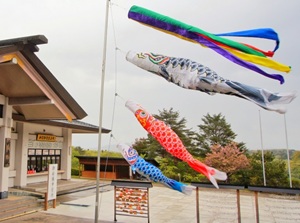
Koinobori (Carp streamers)
May is in late spring and it is like early summer.
Sunrise becomes earlier and sunset is later, so the days get longer.
The sunlight is very bright and the climate is comfortable.
Golden Week is in the good season.
In Japan, some national holidays are set up from April 29 to May 5.
- April 29 : Showa Day
- May 3 : Constitution Memorial Day
- May 4 : Green Day
- May 5 : Children's Day
May 5 is Chidren's Day.
It is the day to celebrate all children.
Originally it was called Boy's Festival and it was for celebrating healthy growth of boys.
Families with boys set out Boy's Festival dolls, patterned after warriors and heroes, and fly Carp streamers (Koinobori).
Carp have the strength to swim up waterfalls and have been the symbol of success in life.
In many companies, May 1 (May Day) is a holiday.
Saturday and Sunday are added, so a long vacation period for over a week is formed.
This is called Golden Week, and many people enjoy a holiday.
Therefore, the transportation facilities are crowded and most accommodations are fully booked.
So, if you want to travel around Japan in the period, you should consider the condition in Japan.
But, after Golden Week, sightseeing spots are in the off season because Japanese people must work again.
The period may be a good chance of travel for you.
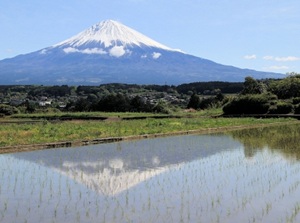
Rice fields in May
Rice is the staple food of the Japanese.
In May, rice-planting is held in many areas in Japan.
Rice fields are flooded and rice sprouts are planted.
The wide fields with water is the Japanese rural scene in spring.
You will be able to see the scene in the train or bus.
In late May, the temperature is often over 25°C.
In Okinawa islands, the rainy season called "Tsuyu" starts and rainy or cloudy days continue.
Summer
June

Suigo Sawara Ayame Park (Iris garden) in Chiba Prefecture
From around the middle of May, the day's high temperature is often over 25°C and the climate is in early summer.
In June, the temperature is sometimes over 30°C.
Humidity is getting high.
In the mainland of Japan, there is a rainy season named Tsuyu (梅雨) between spring and summer.
Cool and dry air mass from northwest and hot and wet air mass from south form the seasonal rain front around Japan.
Therefore, rainy or cloudy days continue for about a month.
The start of Tsuyu is announced in each region by Japan Meteorological Agency.
Okinawa islands are already in Tsuyu season in mid-May, and the mainland of Japan is in Tsuyu in mid-June.
And the rainy area by the seasonal rain front doesn't reach Hokkaido, so Hokkaido has no Tsuyu.

Hydrangeas in Meigetsuin temple (Kamakura city)
In this season, sweet-flags and Japanese irises are popular.
They look very similar and there are the gardens for them in many cities.
And hydrangeas are also seen in this season.
The hydrangea is native to Japan, and it has an image of flower in rain.
There is no national holiday in June.
Therefore, many sightseeing spots are in the off season in June.
July

Lavender of Farm Tomita in Furano city in Hokkaido
Photo by Railstation.net
In Okinawa islands, Tsuyu finishes in mid-June.
So, the islands are in midsummer in July.
Hokkaido Island is out of Tsuyu area.
So, the climate in Hokkaido is hot but comfortable in July.
The temperature is 25°C to 30°C and the humidity is lower than Honshu island.
Tsuyu continues in the mainland of Japan in early July.
There are many cloudy or rainy days and the humidity is high.
The temperature is often over 30°C.
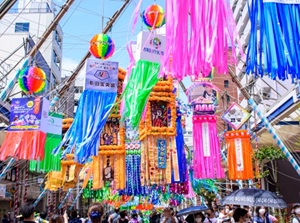
Tanabata Festival in Hiratsuka city
July 7 is the day of Tanabata festival.
It is a traditional festival from China, and it has the romantic legend that the stars of a boy and a girl can meet around the Milky Way on this day once a year.
People write their wishes or poems on strips of colored paper, and they hang the strips on leafy bamboo.
The bamboos with colorful strips are displayed in the shrine so that all these wishes will come true.
In many towns, the festivals with many colorful decorations hung over the streets are held.
In mid-July, the seasonal rain front becomes weaker rapidly and the rain clouds disappear from Japan.
The end of Tsuyu is announced in each region by Japan Meteorological Agency.
This is the start of midsummer in Japan.
The sunlight is very strong and the air is a little humid.
In the mainland, the temperature exceeds 30°C every day, and it is sometimes over 35°C.
But the temperature in Okinawa is a few degrees lower than the mainland.
Most schools start summer holidays in late July, so you will find many young people in any sightseeing spot.
August
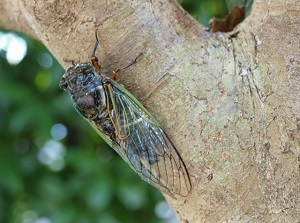
A cicada on a tree
It is very hot and humid in August.
Every day the temperature in the mainland is over 30°C and is often over 35°C.
Recently, it exceeds 40°C sometimes in some places in the mainland.
The snow on the top of Mt.Fuji disappears in this season.
In addition, the temperature in the night is over 25°C in many days.
The night is called "Tropical night" in Japan, and we cannot sleep well.
When you visit Japan in late July and August, you should be sure to take precautions against the heat.
Foreign travelers are surprised at buzzing of cicadas.
Cicada is a kind of insects and sings like a buzzer on a tree trunk in mid-summer.
A lot of cicadas are on many trees even in the center of the city, so you hear the loud buzz everywhere.
You may feel it as a noise, but Japanese people feel it a common feature in the summer time.
It is very fine in most days in August.
But storm clouds sometimes appear locally and there is a heavy thunder storm for a short time.
If you are out of doors, that is dangerous.
And severe storm "typhoon" comes to Japan a few times in summer.
You can know it in the page Typhoon.
If you have been caught in a typhoon in Japan unfortunately, you may be forced to change your schedule.
In Japan, the day of August 15 is called Obon.
Japanese people have believed that ancestral spirits return their home in the period according to Shinto and Buddhism.
Therefore, many families in the big cities return to their hometown.
They visit their ancestors graves and spend time with their family.
Between early August and around Obon, Bon dance festival are held in the evening in each town and village.
The people in the area dance freely and anyone can join the dance.
And large-scale fireworks displays are held in major cities in the period.
They are very attractive events in midsummer.
During a few days before Obon, all trains, airplains, roads from Tokyo area are very crowded.
For a few days after Obon, the transportations toward Tokyo area are very crowded.
If you travel around Japan in the period, you will have a hard time.
In addition, national memorial services are held for Japanese people who had died in World War II. (1941-1945)
Especially, the events in August, 1945 led to the current peaceful nation of Japan.
- August 6 : Atomic bombing for the first time in Hiroshima
- August 9 : Atomic bombing for the second time in Nagasaki
- August 15 : The unconditional surrender of all Japanese armed forces, and the Emperor's declaration of defeat in the war to all Japanese people
The prime minister attends each ceremony.
And, the Emperor and Empress attend the Memorial Ceremony for the War Dead on August 15.
(Coincidentally, the day is the same as Obon.)
In August, Japanese people have some occasions for praying.
Autumn
September

Mt.Fuji without snow and cosmoses in early autumn
It is still hot in the early September.
The day's high temperature falls finally below 30°C in the middle of September.
In Hokkaido, the day's high temperature is below 25°C and falls below 20°C in the late September.
Hokkaido is already in autumn.
The sound of the cicadas has already faded away and the town is quiet.
Instead, we can hear the gentle chirping of autumn insects in the grass.
After long summer holidays for over a month, most schools reopen at the beginning of September.
So summer's leisure facilities become an off-period.
Typhoons come to Japan even in September.
The number is almost the same as August, but some of the typhoons are more powerful than August.
So, you need to know the information of typhoon in Japan.
In the middle of September, the temperature drops to around 25°C.
Because we have already accustomed to the heat of summer, we feel cool and comfortable.
In this season, cosmos is popular in many parks and fields.
And red spider lily comes out in the rural area.
These are the scenery in early autumn in Japan.

Red spider lilies in Nara Prefecture
In this period, there is a rainy season between summer and autumn.
It is from around the late September to early October.
The rainy days are not so continuous, and drizzling rain mainly falls.
So, this rainy season is not called "tsuyu" in June and July.
In Hokkaido and Okinawa area, the rainy season doesn't appear clearly.
So, we have a lot of fine days in Sepermber.
October
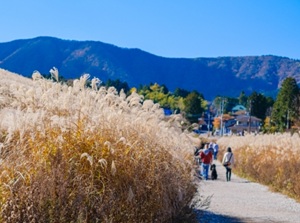
Field of Susuki in Hakone
October is a good month to travel around Japan.
In the mainland, the day's high temperature falls from around 25°C to below 20°C in the end of October.
The temperature in October is similar to May, but the humidity is lower than May.
So, it is very comfortable and the color of the sky is clearer than spring.
The nice weather continues and rainy day is once a week at most.
The time of sunset is 1.5 to 2 hours earlier than May.
Because the altitude of the sun is very lower than May, shadows are long and the shade of the scenery is clear.
Cosmos, roses and various flowers bloom in the gardens and fields.
And, Susuki (Japanese pampas grass) in the open fields and hills has been popular with Japanese people since ancient times.
The color is quiet, but it matches well in autumn scenery in Japan.
Susuki has been used in the autumn ceremony and event of Shinto shrine.
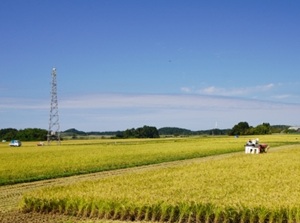
Harvesting rice in autumn
From September to October, rice harvest is held in most areas in Japan.
Wide rice fields like golden carpet return to the field of earth.
This is the Japanese rural scene in autumn.
In Okinawa, the temperature is still from around 30°C to 25°C.
The climate is in the late summer.
In Hokkaido, the temperature falls from around 20°C to 15°C in the end of October.
October is the best time to see autumn leaves in Hokkaido.
In addition, it began to snow on the top of Mt.Fuji in October, and we can see Mt.Fuji with white top again.
In the middle of October, the leaves begin to change colors in Tohoku region and high mountains including Mt.Fuji.
Halloween is a Western festival on October 31.
It is unrelated to Japan, but it became an event that young people dress up and go out to town since the 2000s.
But, many young people including foreign tourists have created a nuisance in the downtowns in the big cities on the day, so half of Japanese people dislike or are not interested in Halloween as a troublesome event.
Now, as the countermeasure, many popular downtowns are sealed off on the day.
If you want to visit Japan for the purpose of Japanese Halloween, you had better think well.
November
The climate in November is similar to October.
The nice weather continues and rainy day is once a week at most.
This month is also a good season for travel.
In the mainland, the day's high temperature is around 20°C in early November and drops to around 15°C at the end of November.
The temperature is mostly the same as the season of charry blossoms around March or April.
But, in November, after the temperature drops little more, the leaves are changing colors.
Late November is the best time to see the autumn leaves in the mainland.
In Japan, there are various kinds of trees in the forest.
The leaves turn red, orange or yellow and there are also evergreen trees.
The colorful scene is the feature of the forests in Japan.
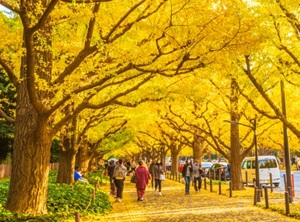
Gingko trees along a street in Tokyo
Maple is the most popular tree and the color turns from green to yellow then bright red.
The leaves of Sakura (Cherry tree) turn from green to dark red.
Gingko is a common tree as the street tree in Japan, and the leaves turn from green to vivid yellow.
In Hokkaido, the day's high temperature is around 10°C in early November and drops to around 5°C at the end of November.
It snows in some days.
So, November is in early winter in Hokkaido.
In Okinawa, the temperature is 20°C to 25°C.
We can't see the autumn leaves in Okinawa.
Winter
December

Snow falls in Ginzan Onsen in Yamagata Pref.
In December, Hokkaido and the north part of Tohoku region are already in midwinter.
The day's high temperature is below 5°C.
Snowy days increase and the snow lies on the ground.
In Okinawa area, it is similar to the season of spring or autumn in the mainland.
In the mainland, Decemeber is the season from the end of autumn to early winter.
The day's high temperature is around 15°C in early December and drops to around 10°C at the end of the year.
It almost never snows in the most parts of the mainland.
The autumn leaves season ends by early December, and dead leaves fall to the ground.
Sunrise is very late and sunset is very early.
December is an off-period of sightseeing spots.
Shiwasu (師走) is another name of December in Japanese.
It means that even Buddhist priests run around busily.
As the name implies, Japanese people work for closing the year busier than the other months.
In Japan, there is a custom called "Bonenkai" in December.
It is a drinking party held among groups of co-workers or friends.
The purpose is to forget the woes and troubles at their workplace in the year, so they realize the end of the works of the year.
Therefore, many izakaya (Japanese pub) and restaurants are crowded.
The towns begin the preparations for Xmas and the New Year.
The streets in the popular areas are illuminated, so the scene is beautiful and fantastic.
And, the sales battle for Xmas and the New Year is started.
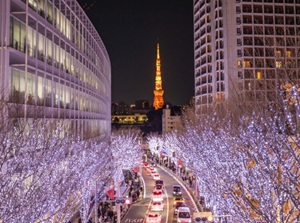
Christmas illuminations in Tokyo
Xmas in Japan is not religious event because Japan is not a Christian country.
Japanese people decorate the Christmas tree, eat Christmas cake, and the children are given Christmas presents by the parents.
They have a pleasant evening on Christmas Eve (December 24), but the day of Xmas (December 25) has few event for the family.
After Xmas, Japanese society changes to the preparations for the New Year.
Rather, Japanese New Year is a traditional event including religious meaning.
Many people visit the markets and shops to get the foods and various goods for the New Year.
Traditional New Year's decorations are put on the gate of house, building, Shinto shrine, Buddhist temple to welcome the New Year.
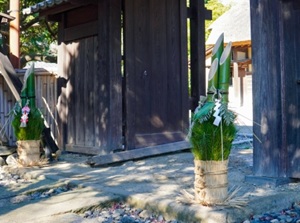
New Year's decorations made of bamboo and pine in front of a shop
Most schools start winter holidays.
And, most companies and government office start New Year holidays around December 28.
And many sightseeing facilities are also closed.
Therefore, from December 30, economic activities in Japan becomes only the preparation for the New Year.
Many families return to their hometown.
From around the day to the end of the year, all trains, airplains, roads from Tokyo area are very crowded.
And many shops and restaurants are also closed.
Hotels and ryokans are available, but major hotels may be sold out by the guests for New Year vacation.
If you travel around Japan in the days, you will cause inconvenience.
December 31 is called "Omisoka" in Japan, and the traditional events are held in Buddhist temples.
By 0 o'clock, the priests ring a large blonze bell 108 times slowly.
According to Buddhist teaching, human beings have 108 worldly desires, so the ringing purifies them.
In the night, many Japanese people wait for the New Year in their home, in the Buddhist temple or Shinto shrine.
January

The new year's visit to Naritasan Shinshoji temple
January 1 is the New Year’s Day and it is a national holiday.
But the three days from January 1 to 3 are called Shogatsu (正月) in Japan, and whole Japanese society is in vacation.
Originally, Shogatsu is a ceremony of Japanese Shinto to welcome the lucky goddess of the year.
So, Japanese people put the New Year's decorations on the gate of house.
And, they visit any Shinto shrine or Buddhist temple and pray for happiness of that year.
They buy the lucky charms to protect the house and decorate them at home.
It is said that half of all Japanese people visit Shinto shrine or Buddhist temple during the three days.
Therefore, major shrines and temples are very crowded.
Many shops and restaurants are closed.
In addition, the families in their hometown start returning to the big cities from January 2.
For a few days, all trains, airplains, roads toward Tokyo area are very crowded.
It may be inconvenient for you to travel around Japan in this period.
After January 4, everyday life of Japanese people starts again.
On around January 7, most schools end winter holidays.
Many sightseeing spots are reopened, but they are in the off season in January.
The 2nd Monday in January is Coming of Age Day.
Since ancient times, people come of age when they are 20 years old in Japan.
The ceremonies for new adults are held in all towns and cities, and many young people take part in it.
You will find young Japanese people dressed up in Kimono or suit.

January is the coldest month in the year.
In Hokkaido, the day's high temperature is below zero.
In northern Tohoku area, it is below 5°C.
In the other areas of mainland, it is 5°C to 10°C.
But, in Okinawa islands, it is 15°C to 20°C, so this area is warm.
The climate varies depending on the region.
Honshu Island is long and mountain ranges run on the center of the island.
Very cold wind blows from the northwestern continent, and it absorbs much water vapor from the Sea of Japan.
When the wind crosses the mountain range, dense clouds are developed and much snow falls.
After crossing the mountain range, dry wind blows down.

Kenrokuen garden in Kanazawa city in winter
In the result, Hokkaido and the areas along the Sea of Japan have much snow.
The depth of snow in Japan is one of the largest in the world.
Ski resort is opened from early December in Hokkaido and the north part of Tohoku region and from late December in the other area.
January is the best season of ski.
On the other hand, fine and dry weather continues in the areas along the Pacific Ocean side of Japan.
Snow falls only in a few days a year in Tokyo, Nagoya, Kyoto, Osaka, Hiroshima, Sendai, etc.
February

Sapporo Snow Festival in February
Early February is also cold continuing from January.
In Hokkaido, the day's high temperature is below zero.
In northern Tohoku area, it is below 5°C.
In the other areas of mainland, it is 5°C to 10°C.
The temperature rises a little in late February, but spring is still far away.
In Okinawa islands, the day over 20°C increaces.
The sightseeing spots are in the off season in February.
But Chinese New Year is in early February, and many Chinese tourists flood Japan in the period.
Around February, the entrance examinations for universities and high schools are held in Japan.
They are the challenges of the life for Japanese students.
So, when you visit Shinto shrine and Buddhist temple, you may find the students who pray for their success on the exam.
Snow falls in Hokkaido and the areas on the Japan Sea side of Honshu islands.
In February, the snow depth becomes maximum in the season.
So, the festivals about snow and ice are held in some cities in the area.
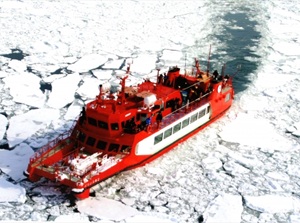
Ryuhyo sightseeing ship from Monbetsu city
From late January to early March, drift ice (Ryûhyô in Japanese) fills the Okhotsk Sea on the northeast coast of Hokkaido.
It is a unique nature.
In the area where it doesn't snow, Ume blossoms (Japanese plum, or Japanese apricot) begin to bloom.
Japanese people feel that spring is just around the corner.






